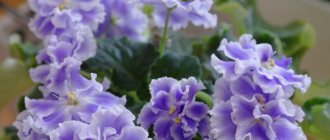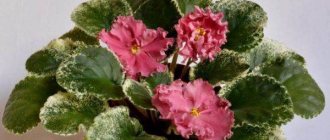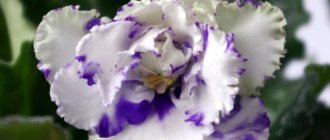Each variety of indoor violets is unique, and despite the external similarity, it has many features.
Care for each individual is also different , sometimes even very different, so it is important to take into account the characteristics of each outlet.
Despite its unpretentiousness, Saintpaulia Blue Mist
requires certain conditions and care to obtain a truly excellent result. In the article you will see a photo and description of the variety.
Pests and diseases
Orchids need fresh air; care must be taken to ensure that the room in which they are located has minimal daily ventilation, but is not exposed to cold winter air.
Affected leaves
Air renewal is necessary in order to avoid the appearance of certain types of diseases, mainly caused by fungi.
Attention! High concentrations of moisture combined with high temperatures and polluted air provide ideal soil for the proliferation of fungi, bacteria and viruses. The most common pests are snails and slugs, especially if orchids are in the garden. If any symptoms of diseases are noticeable, it is recommended to contact a specialist garden center, where experts in the field can help and recommend remedies.
If any symptoms of diseases are noticeable, it is recommended to contact a specialist garden center, where experts in the field can help and recommend remedies.
The most common pests are snails and slugs, especially if orchids are in the garden. If any symptoms of disease are noticeable, it is recommended to contact a specialist garden center, where experts in the field can help and recommend remedies.
With proper care, a black orchid can bloom several times a year. In fact, Phalaenopsis orchids will adapt much better to indoor living than to outdoor conditions. And varieties with black flowers arouse constant interest among everyone.
Appearance: leaves, flowers
Violet leaves are like velvet. The shape can be ovoid, oval, round or with a heart-shaped base. Given the appearance, the outer part of the leaf takes on different colors, ranging from light to dark green. The inner part of the surface is light green or lilac, with pronounced veins.
The main feature of the Blue Fog variety is its light blue and light blue double flowers.
The edges of the petals are framed in white. The inflorescences of the heavenly shade are large in size. They have a spherical shape. Serrated leaves.
Peduncles are long and strong. Flowers rise above the leaves. There are 3 - 4 buds on one peduncle. When blooming in summer, the flowers are a richer shade of blue and may lack a white border. By winter, the color changes to that typical for this variety.
Photo
Next you can see the photo and description of the appearance of the violet “Blue Fog”
A short video review of the violet variety “Blue Fog”:
https://youtube.com/watch?v=s4uhEDjI-3A
Story
The history of the creation of Saintpaulia variety Blue Fog goes back a decade and a half (2001). This variety of blue indoor flowers was invented and bred by a young talented breeder Konstantin Morev. One of the provinces of East Africa can be considered its homeland; after its governor, the flowers were called “Saintpaulia”. Today, over two thousand species of these amazingly beautiful flowers have been registered on the planet, so it makes no sense to talk about them belonging to a separate geographical area.
Flowers in the shade of the sky are endowed with sacred meaning in many nations, and blue violets have found their fans on all continents. And today, few people remember the name after whom they were named - Baron Walter von Saint-Paul. Today, Saintpaulia is one of the most common indoor plants, called the queen of flowers, not without reason.
Distinctive features of care
With careful care and properly selected soil, the plant blooms 10 months a year. At the same time, violets bloom profusely. Even young flowers develop a blue cap.
Rules for caring for violet “Blue Fog”:
- A constant temperature of 20 to 25°C is required.
There should be no draft in the room.
To avoid sunburn, the room must be shaded.
You also need to control humidity; any fluctuations of 50 - 60% of the norm can lead to illness. In a dry microclimate, flowers wither. You can purchase a mini-greenhouse.
Proper watering is important; for this, settled, unboiled water is used, slightly warmer than room temperature. Water with a thin stream, without splashing water on the leaves, no more than twice a week.
There are several factors that determine the timing of watering, these are the size of the pot, the time of year, the temperature and humidity of the room and the time of flowering. In spring - autumn, the plant needs to be moistened more often. Saintpaulia usually requires a portion of water every 3 to 4 days.
If there is a deficiency of nutrients in the soil, the flowers need to be fertilized. For this, liquid organic substances, thin sticks and tablets are used. When flowering, add fertilizer and repeat this procedure every season, if necessary.
Description
Blue fog has fairly large, voluminous inflorescences of a heavenly hue. The flowers are spherical in shape with a wavy, corrugated edge, which is a little lighter than the main color. Not only is Saintpaulia of this variety capable of pleasing the eye all year round, it should be noted that there are really a lot of inflorescences.
Blue flowers are related to the chakra, which is responsible for creativity; they fill the house with creative energy. When breeding sky-colored violets, you can be sure that your apartment will never be gloomy and dreary. The petal tips of the Sky Mist variety are typically green, and the leaves are light green and jagged.
If the white and blue colors symbolize Argentina and the French royal house, then the heavenly Saintpaulia represents concentration and goodwill throughout the world.
After all, in the room where they are located you have to constantly open or close the window to ventilate the air. The same applies to humidity. Any fluctuations from the norm of 50-60% can lead to plant disease. When breeding violets in an apartment, you can purchase a mini-greenhouse.
One of the decisive factors when maintaining Saintpaulias is their watering. The first rule is to water the flowers with settled, unboiled water. The liquid for irrigation should be slightly warmer than room temperature; you can use it for drinking, but it is not advisable.
Water for irrigation should be added in a thin stream, trying to avoid getting on the leaves of the plant so as not to contaminate them. It is not necessary to water violets more than twice a week. From excess moisture, the Saintpaulia root system rots and the flower becomes sick, which manifests itself in brownish spots on the surface of the leaves.
It is advisable to wash violet leaves to remove dust particles once a month. If the volume of plants is small, then the pots can be taken to the bathroom, tilted slightly over the tap and washed off the dust under running warm water. Any remaining water should dry on its own; do not dry it with a hair dryer.
If there is a deficiency of nutrients in the soil, indoor flowers need to be fertilized. Liquid organic substances, small sticks and tablets are used as fertilizers for violets. During the flowering of plants, fertilizing is added to the soil, and this procedure is repeated as long as it is needed each season.
Saintpaulias should be replanted no more than once a year. It is recommended to do this in the fall, then the flowers have time to adapt before the winter cold. Violets should be transplanted in such a way as not to damage the rhizomes, preferably together with a small part of the soil.
These recommendations apply to all varieties of violets, not just the Blue Mist variety.
How and when it blooms in natural conditions
Violet is often found in nature. Each species has its own flowering characteristics. The flowers vary slightly. To the untrained eye, it is quite difficult to distinguish them. If you study the peculiarities of coloring, it will not be difficult. The flowers have the following colors:
- Tricolor - the species got its name due to its color; the flower combines three colors at once: yellow, blue and white. The diameter of the inflorescence is 3 cm. Flowering occurs in May and lasts until September, the bush constantly forms new shoots and flowers;
- Dog - the petals are light blue or light purple, sometimes white, the diameter of the flower is 2-3 cm. It blooms in early May and ends in early July;
- Swamp - the color of the petals is soft purple, a distinctive feature is the presence of dark purple stripes on the lower petal. The diameter of the inflorescence is 3-4 cm. Flowering begins in May and ends by mid-summer;
Violet in a flowerbed
Important! To obtain abundant flowering, you need to create optimal growing conditions and provide proper care.
Comments (2)
Alyona
08/19/2017 at 00:57 |
A very beautiful violet and a romantic name. I also love and grow violets at home. I have long wanted to buy a variety with blue flowers. I have all kinds of white, pink, purple. And the care, it seems to me, is the same for all of them.Answer
Catherine
09.18.2017 at 11:51 |
I breed several types of violets, including Blue Mist. I like them for their abundant flowering. Moreover, for a greater formation of flowers, I trim the small green leaves in the core of the flower and cut off the large, dull, withered leaves along the edges. And then the violet makes me happy with flowers for a long time!
Answer
Pests
Violets, like any other indoor flowers, can be affected by pests and diseases. The most common pests found on Saintpaulias are:
Spider mites are dangerous and fast-spreading insects that feed on plant sap.
Violet that is not affected by pests (photo)
The main sign of its appearance is a white sticky coating on the surface of the leaves. To kill ticks you need to use special preparations. For example, “Fitoverm” or “Aktellik”. Other insecticides are ineffective against this pest.
Whitefly is a dangerous pest of greenhouse and indoor plants. Most often it appears when the air humidity is too low and the temperature is too high. To destroy it, it is best to use systemic insecticides that have the ability to accumulate in parts of the plant.
The mealybug is a sucking pest that feeds on plant sap. Violets infected with it are severely stunted in growth and die if left untreated. It is not difficult to destroy these pests. A solution of laundry soap helps in the fight against them.
Expert opinion
Yulia Yurievna
I have a large garden and vegetable garden, several greenhouses. I love modern methods of cultivating plants and mulching the soil, and I share my experience.
Since this is a very contagious insect, it is better to immediately isolate the affected specimen. To reduce the population, you can buy violets. This should be done carefully so that water does not leak into the pot. You need to hold the flower at an angle or cover the soil in the pot with film.
The drug Neoron can also be used for treatment. This remedy affects not only adults, but also their larvae, damaging the shell. Even when using such a strong drug, treatment alone is not enough.
In the fight against such pests, it is difficult to destroy the larvae. There are means that sterilize females of such ticks. Then it's easier to deal with them.
If mites are found on a flower window, you need to carry out preventive treatment for all other flowers, as well as disinfect their place of residence. It's even better to iron the curtains.
We would like to note that violets are sometimes affected by scale insects and false scale insects. Yellowish tubercles appear on infected leaves. Even one such pest is very dangerous; scale insects multiply quickly.
To begin with, spotted individuals are removed with a brush or cloth in alcohol or soap. Next, you need to treat with Actellik or Aktara.
While watching the video you will learn about the Blue Mist violet.
https://youtube.com/watch?v=vt7hBJvDPnU
Terry Saintpaulia variety Blue Fog is a beautiful and rather unpretentious indoor plant. Growing it at home is not at all difficult. Even a novice gardener can do this task.
Violets
How to register a new variety?
Nowadays, no one is involved in the registration of domestic varieties at the level of institutes or institutions of this type.
You can register the variety on some websites or try to do it through the Institute of Biology.
In the first option, registering a variety is free and takes little time. In government agencies, this process can last months and cost some investment.
In addition, you can register your varieties on foreign resources, but this is usually not free. For example, registration for AVSA is paid and this is not an indicator for most flower growers.
Popular articles Characteristics of black pine Oregon Green
If you do register a variety, then it is worth knowing the sequence of this process:
- After obtaining a new variety, it is fixed in at least three generations (when registering with government agencies, the procedure for fixing and checking can be carried out themselves, but in our time this is rare);
- Submitting an application for registration. On most sites, this requires at least two photos of the rosette (large flowering and the entire rosette) and a description of the parameters. All additional data will be requested if necessary. You can come up with a name right away, otherwise the variety will be assigned a number and then not all resources can change it to the name;
- Waiting for the result. After checking the similarity of the new variety to those already registered and the absence of strongly similar variants, the variety is assigned a number and name. The name is chosen either by the breeder himself when submitting an application, or with his permission, a competition is held and the best option is selected.
Pollination of parent plants
The main way to develop new varieties is pollination. To do this, select two parent varieties according to the parameters outlined above.
Then the long process of elimination begins:
timing of pollination - it is extremely important to carry out the pollination process on time: the mother flower (which is pollinated) should be no older than 3-4 days, the main indicator is the stickiness of the tip of the pistil; the father's flower, on the contrary, must be well-ripened, no younger than 3-4 days, depending on the duration of flowering of the variety.
Attention! Pollen can be used from dried flowers; the storage time of such material is about six months, this simplifies the selection process by eliminating the need for simultaneous flowering of the parent bushes.
When choosing a mother bush, it is important to carefully examine it or even prepare it in advance. The rosette must be healthy and strong enough for the seed pod to ripen on it
The paternal rosette can be anything, but a healthy rosette has a higher chance of successful pollination; those flower growers who do not risk taking dried pollen must first align the flowering cycles of the parent rosettes: to do this, the flower stalks are cut off on a bush that wants to bloom much earlier than the second; Another option is to remove several flower stalks from both bushes and move them to cool conditions, and then expose them to plenty of light and warmth, after which they usually bloom together.
After all the preparations, it’s time to pollinate the flower. For this:
cut off the anther from the father's flower;
break or cut it; holding the anther tightly with tweezers or picking it up with a needle, dip the stigma of the pistil inside the crack; pollen should remain on the sticky tip (a noticeable change in its color); some gardeners simply place the anther on the pistil for a better effect.
- A successfully pollinated flower shows this after a few days. A compaction appears under the pistil, which is the future seed pod;
- seeds ripen from 1.5 to 8 months, it all depends on the conditions and the mother plant. You need to wait until the box dries. It must be remembered that seeds that have matured longer have better germination, for example, 1.5-month-old seeds often do not germinate at all;
- After receiving the seeds, they are sown, preferably as soon as possible. Sowing is carried out in moist soil, without sprinkling with soil on top, covered with film and periodically sprayed, the temperature for germination is 22°C;
- The children are raised in a greenhouse for a long time, periodically ventilated. Picking is carried out 2-3 times, depending on the density of the seedlings;
- after transplanting into separate flowerpots, the care of the young plant coincides with the care that is provided to the planted baby, obtained by the vegetative method;
- During the growth process, “unnecessary seedlings” are culled. Those rosettes that, according to the parameters set by the breeder himself, do not pass and are not interesting to him, are simply thrown away or given away;
- The last step to obtain a new variety is to check the result or consolidate it. In order to be called a full-fledged variety, a flower must transmit varietal characteristics when propagated by leaves or stepsons from three generations or more. Until then, I consider the plant to be a seedling.
To obtain specific parameters, multiple pollination is often used, thus adding more and more new rosette and flower parameters. To do this, a suitable seedling after the first pollination is dusted during the second flowering or pollen is taken from it and mixed with a suitable variety.
The process is repeated until the desired result or varieties are obtained that interest the breeder more than his original plan. This procedure is very labor-intensive and such work may take years, but the reward will be the varieties bred at the intermediate stages and, most importantly, a new, unique, final variety.
Pollination of Saintpaulias is a very complex process, especially for indoor bred species. Their anthers grow together, which virtually eliminates both cross-dusting and self-dusting.
In rare cases, the coincidence of damage to the anther in some way and the presence of an insect or other method of transferring pollen leads to dust.
Self-pollinating violets at home is almost impossible.
Conditions of detention and care
Violet Frosty cherry is warm and light-loving.
It is possible to achieve the correct flowering and development of the plant, characteristic of the variety, only if the following conditions are met:
- Sufficient illumination. The violet reacts to a lack of light by stretching out the peduncles and turning the flowers pale. Violet needs bright but diffused light, so it is better to install it on east or west windows. The leaves should not be exposed to direct sunlight, which will cause burns. Excessive light causes clogging of the center of the socket, so in summer it is better to shade it even on eastern and western windows.
- Air temperature from 20 to 25 degrees. A decrease or increase in temperature will not destroy the violet, but will affect flowering. In the heat, the flowers will be small, and at temperatures below 16 degrees the violet will stop blooming altogether.
- In insufficient light, the flowers of the Frosty cherry violet turn pale.
Air humidity is not less than 40 and not more than 65%. Heat combined with high humidity affects the flowers: they become simple, without terry. The room where the violet is located must be ventilated daily. The lack of moisture is compensated by installing open containers with water next to the violet. Spraying the plant to replenish moisture deficiencies is contraindicated.
- Regular watering with soft water at room temperature. The plant should be watered only after the soil has dried to a third of its height. Overwatering leads to rotting of the root system, and the plant may die.
Organization of fertilizing
Overfeeding violet Frosty cherries is harmful. The variety does not like nutrient-rich and dense soils. Such compositions inhibit the plant and reduce the quantity and quality of flowers. The violet begins to hurt.
If the plant shows signs of depression and begins to lose its attractiveness, it is recommended to replant and replace the soil. The soil needs to be poor in nutrients and as light as possible.
Adult plants are fed once every 2-3 weeks with organic and mineral compounds. Organic matter is added during the formation of the rosette, mineral mixtures are added during flowering. The first feeding is carried out 30 days after transplantation.
Transfer schedule and rules
Frost cherry violet is replanted twice a year. In this case, the size of the pot is gradually increased as the roots of the rosette grow. The maximum diameter of a pot for an adult violet is 12-13 centimeters.
A complete replacement of the soil during replanting is done if there is a suspicion of the presence of a disease.
If the plant looks healthy, transplantation is carried out together with a clod of earth. The slightest signs of trouble are a reason to completely replace the soil
In this case, remove the violet from the pot, carefully shake off the old soil from the roots and place the plant in a new pot.
To grow violets, you need the lightest and loosest possible soil. Special soil for violets is ideal, but to increase looseness you need to add perlite or vermiculite, approximately 10% of the total volume.
If it is not possible to purchase ready-made soil. You can prepare the substrate for planting yourself. The basis of the mixture is leaf or turf soil. It needs to be added to the mixture of 5 parts.
Popular articles When boletus mushrooms begin to grow
Add 3 parts peat and 1 part sand to the prepared soil. Then mix everything with vermiculite or perlite (10% of the total volume). For disinfection, a small amount of wood ash and sphagnum moss is added to the mixture.
Growing from seeds
Viola Seeds
The seed method of propagating pansies is quite simple. First you need to choose a sowing time.
It depends on when you want to see the first flowers:
- In order for the plant to bloom next year, it must be sown in open ground in the fall. This should be done in August or September. Viola will have time to sprout and its root system will begin to form. By the time frost sets in, it will be a fully formed bush. Having overwintered, it will give you flowering in April, which will continue until autumn.
- If you plant pansies in the spring, they will bloom the same year they are planted. Here it is necessary to use the seedling method. We will look at it below. This planting is carried out at the end of winter.
- If you sow the seeds in May or June directly into the ground, the viola will begin to bloom in September. Winter will find it blooming, but next year it will bloom again.
Step-by-step instructions for growing seedlings:
First shoots of seedlings
Before sowing, it is recommended to treat the seeds with a solution that stimulates growth, for example, you can use citron. If the seeds were purchased from an unreliable seller, they need to be disinfected with a weak solution of potassium permanganate.
Pansy seeds can be stored for no more than two years, after which they lose their viability.
You can make the mixture yourself. To do this, garden soil, peat and rotted compost are mixed. The proportion should be 2:2:1.
Be sure to spill the self-prepared soil mixture with a hot solution of potassium permanganate. This will kill any fungal spores that may be waiting in the garden soil.
The first method: spread the planting material on moist soil. Cover with film and keep until sprouts appear in a dark place at a temperature of 22 degrees. Every day you need to remove the film for 10 minutes for ventilation.
Second method: Seeds are sown in furrows. The depth that should be is about 0.5 cm. The distance between them must be kept 1-2 cm.
The step between the seeds should also be 1 - 2 cm. After the grooves are sealed, you need to water the viola. Cover with film and place in a warm place.
Such sowing does not require keeping in the dark. The film also needs to be removed every day, for 10 - 15 minutes. Depending on the variety and quality of planting material, the first shoots will appear in 2 - 4 weeks.
Viola seedlings
- After the seedlings emerge, the container with seedlings should be placed in a well-lit place. Viola is not afraid of the spring sun, so the window sill of a south window is suitable for her.
- The film cannot be removed from the seedling container immediately. It is necessary to accustom the seedlings gradually. To do this, you need to increase the ventilation time throughout the week.
- Pansies can feel quite comfortable at a temperature of +5+10 degrees. Therefore, during the day, seedlings can be taken out to the balcony, terrace or yard. Fresh air will contribute to its rapid strengthening and growth.
- Viola needs regular watering. It is produced when the top layer of soil dries. However, you should not overwater, as excess moisture will cause the plant to rot.
- Picking is done after 2-3 full leaves have grown. Transplantation is carried out into separate cups. Viola takes root well, so if the root is damaged, it’s not a big deal. This will not deteriorate the health of the plant, only growth may slow down a little.
- If the stem of the dived pansy has stretched out. It can be deepened into the ground almost to the leaves. This will improve the appearance of the plant and make the root system stronger. New roots will grow on the surface of the recessed stem.
- After several pairs of leaves have formed, you need to pinch the top of the stem. This will make the bush lush.
- Planting in open ground is carried out after stable weather has established, without frost. The distance between bushes should be at least 10 cm.
Pansies tend to self-pollinate
Therefore, you should not be surprised when you see flowers of an unexpected color in your flowerbed. By the way, it can be propagated by collecting seeds.
Sowing seeds in open ground:
- Make shallow grooves. The gap between them should be 10 cm.
- Spread the seeds, keeping a distance of approximately 1 - 2 cm.
- Water the crops and cover with film.
- After the shoots emerge, the film is removed. Seedlings need to be provided with partial shade conditions. For this purpose, a canopy is constructed. Or tree branches with foliage are installed along the perimeter of the bed.
- Transplantation to a permanent place is carried out after the appearance of 3 leaves.
In order for the bushes to bloom profusely next year, it is not necessary to allow flowering in the first year. To do this, all the buds are cut off.
Bergenia: description, types and varieties, planting and care in open ground, medicinal properties and contraindications (60+ Photos & Videos) + Reviews
Distinctive features of care
With careful care and properly selected soil, the plant blooms 10 months a year. At the same time, violets bloom profusely. Even young flowers develop a blue cap.
Rules for caring for violet “Blue Fog”:
A constant temperature of 20 to 25°C is required.
There should be no draft in the room.
To avoid sunburn, the room must be shaded.
You also need to control humidity; any fluctuations of 50 - 60% of the norm can lead to illness. In a dry microclimate, flowers wither. You can purchase a mini-greenhouse.
Proper watering is important; for this, settled, unboiled water is used, slightly warmer than room temperature. Water with a thin stream, without splashing water on the leaves, no more than twice a week.
There are several factors that determine the timing of watering, these are the size of the pot, the time of year, the temperature and humidity of the room and the time of flowering. In spring - autumn, the plant needs to be moistened more often. Saintpaulia usually requires a portion of water every 3 to 4 days.
Soil preparation
To plant Saintpaulia seeds, you can use ready-made soil. You can also make your own flower nutrient mixture. The ready-made version can be purchased at any store specializing in indoor plants.
Here are several options for compositions that the gardener can make himself.
- You should mix the deciduous, peat, turf and coniferous components in a ratio of 3: 2: 1: 1. Then you need to add crushed sphagnum, vermiculite or, for example, perlite, for loosening. It is also advisable to use charcoal.
- You need to mix the coniferous and turf parts in a 1: 1 ratio. Then you should add peat and crushed sphagnum in the same quantities. You should also add a double dose of the leaf component and half of the sand (1: 1: 1: 1: 2: 0.5). It is useful to add coal as a sorbent, fertilizer (K, Ca, F), as well as an antibacterial composition.
- It is necessary to take garden soil from the garden bed where legumes were grown. Soil from mole holes is also suitable (it is the most granular). For 4 parts of land you need to take 1 part sand and 1 part black peat.
Each ingredient should be sifted and cleared of plant debris so that rotting does not interfere with the healthy growth and development of seedlings.
There are many recipes for soil for violets, but none is the only correct one. It all depends on the quality of the ingredients
It is important that the soil is not very greasy, loose, absorbs moisture well, but at the same time allows air to pass through so that the roots do not rot. You can use different ratios of parts to get your mixture experimentally
Before planting plants in the soil, it is necessary to disinfect it with heat or cold (steaming or freezing). You can also use a solution of foundationazole or another drug. To protect plants from infection with any diseases, you can sprinkle the seeds with fungicidal powder. This is especially necessary when using components obtained independently outside the city.
For example, the use of sphagnum in soil composition has a powerful antiseptic effect.
Additional Tips
In case of lack of nutritional properties of the soil, use:
- liquid organic matter;
- thin sticks with feeding mixtures;
- garden tablet fertilizers.
Fertilizing is introduced at the first flowering. It should be repeated only in those seasons when there is a need. You can only grow Blue Mist in a pot if you use the right soil mixture. It should not be too dense; looseness is welcome. The optimal composition of the mixture is made from 5 parts of dry peat, 3 parts of soil and 1 part of washed river sand.
There is no particular need to make such a composition yourself. Similar soil mixtures are sold in any specialty store. “Blue fog” is grown in nutritious soil that easily absorbs moisture
It is very important that its acid-base balance is slightly acidic; perlite is used to improve store-bought soils. The addition of perlite helps make the soil structure lighter and more airy.
Usually the nutrients in the planting mixture last for 1.5-2 months. By the end of this period, it is necessary to replenish their supply with the help of fertilizing. When it is necessary to help the development of the rosette, nitrogenous substances are used. Potassium compounds help strengthen flower stalks and prevent them from being damaged by diseases.
Important: if you have no experience, it is best to use ready-made complex mixtures. There are exactly those substances that are needed most, in the best proportions, and in the ideal chemical form
You can grow violets in plastic or ceramic containers. The lightness of plastic and its long service life make this material very popular. However, it must be taken into account that air does not pass through it. Therefore, you will have to either choose a breathable material or make special holes. The size of the pot is also carefully selected: in an overly large container, “Blue Fog” forms a powerful root complex, but is in no hurry to bloom.
If you have to illuminate the plant, then use only fluorescent lamps. There should be approximately 25 cm between the flower and the light source. When Saintpaulia develops, it is transplanted to a new place. If at first a pot with a diameter of 4 or 5 cm is enough, then after 6 months it should already be 9 cm.
When a plant is replanted, diseased and dry leaves are removed at the same time. The normal development cycle of a violet is 3 years. In the fourth year they become less beautiful and more susceptible to disease. You can solve the problem by cutting off and rooting the top. Special preparations are applied to the incision areas.
“Blue Fog” must be protected from:
- whiteflies;
- spider mites;
- powdery mildew;
- mealybug;
- fusarium.
In the next video you will find a review of the Blue Mist violet variety.
Caring for a plant at home
Blue Fog is a completely unpretentious variety, but to get a good rosette and abundant flowering you will have to follow the rules.
Place of cultivation
The variety feels great on the windowsill and under a lamp; it has no tendency to pull or droop the leaves. You just have to remember that direct rays of the sun leave burns.
Temperature greatly affects the color of flowers
If you create cooler conditions (it is important not to drop the temperature below +18°), the flowers will be lighter, sometimes almost white with a slight blue print, almost a dusting
When the temperature rises excessively (26°-28°), the flowers darken, there may be completely blue prints, with a blue edge, and sometimes the flowers turn completely blue. The optimal temperature range is considered to be from 22 to 24°.
Air humidity above 70% leads to rotting of the leaves and growing points, which leads to the death of the flower. Overdried air, up to 50%, leads to softening of the sheets and their wilting. It is recommended to maintain this indicator in the interval between the lower and upper acceptable limits.
Watering and fertilizing
Watering and fertilizing are carried out using two main methods:
- Add water to the tray (under the leaves) once a week - in summer and a little less often in winter. After watering, excess water is drained 20 minutes after the procedure. Fertilizers are applied periodically, approximately once every 2-3 weeks, depending on the season (through watering), and the dosage is halved;
- Wick - a cord is placed in a pot and brought out through a drainage hole, a container with water is placed under the flowerpot. There is always water in the container, and fertilizers are constantly there, and its concentration decreases by 7-8 times, relative to the instructions.
Replanting and pruning
For replanting, it is important to choose the soil; you can buy a ready-made mixture for Saintpaulia, or make it up from:
- Peat;
- Sheet soil and perlite with the addition of sphagnum moss;
- Or coconut fiber.
The proportion depends on the type of irrigation:
- For the first -1/1/1/0.5;
- For the second one 1/0/1/0.1.
Pruning is carried out regularly, removing dying parts of the rosette (leaves and peduncles, roots during transplantation). Planting material for propagation is also cut off - leaves of 2-3 rows, not completely faded peduncles and stepsons.
Popular articles Is it possible to eat overgrown champignons?
Transplantation is carried out for several reasons:
- To replace the pot - as the pot grows, the rosette with a lump of soil is transferred;
- As planned, to replace the soil - approximately once a year, without changing the flowerpot, the soil is replaced, and dead roots are removed;
- In case of illness, the transplant is carried out as in the previous case, but the flowerpot and plant are additionally processed.
Reproduction
This variety reproduces well by any convenient method:
- Leaf cuttings - leaves of the second and third row are rooted in soil, water or moss;
- Stepchildren - grown stepsons are separated and planted (provided they have their own roots), or rooted as leaf cuttings;
Violet is often propagated by leaf.
- Peduncles - not completely wilted peduncles are rooted in the soil under the film.
Important! The variety is very prone to sporting, and this factor does not depend on the type of propagation. It is important to leave a lot of children before flowering, so that later you can select varietals.
Reproduction
We have already discussed the features of viola seed propagation above and will not repeat ourselves; we will only clarify that when planting in the ground, you must certainly follow the rules for zoning flowers of different varieties. Otherwise, cross-pollination occurs, and next year the plants will look a little different - sometimes not at all the way their owners want.
Few people know that annual and perennial pansies can also be grown from cuttings. Usually in the second season the flowers become smaller and require renewal. To do this, the bed is thinned out, leaving only stems with unblown ovaries on each bush, and the bushes cut at the end of May with a couple of internodes are transplanted into universal soil. During this period, the plant requires abundant watering, preferably using biostimulants - this way the development of the root system will go faster
If the summer is dry, then cuttings are carried out under a film, since at this stage it is important to maintain constant moisture in the top layer of the earth
About the violet blue fog moreva: what the seeds look like, pollination at home
Violet is a decorative flower that is grown indoors. The Blue Fog Moreva variety is very popular among many gardeners due to its double flowers of a pleasant heavenly shade, easy care and simple propagation.
Features of violet care Blue fog Moreva at home
The plant is easy to care for, but in order for it to grow well and not get sick, certain conditions must be observed.
When and how does it bloom
Violet Frosty cherry - description and characteristics of the variety
With proper care, violets can bloom 10 months a year. The rosette begins to grow at 11 months.
This is an amazing plant, the shades of its flowers depend on the temperature. If you want to get a delicate, almost white inflorescence with a slight blue, the plant should be kept at a temperature no higher than 20 degrees. The warmer the room, the darker the violet blooms.
Inflorescence shapes
The plant always blooms with a large head. The emergence of buds is directed towards the center; they are supported on strong peduncles.
The Blue Fog variety is popular due to the fact that its flowering can be enjoyed for a long time. It happens in waves. Each bud lasts a long time.
Changes in care during the flowering period
If the violet blooms for a long time, it is necessary to improve the conditions for its maintenance.
It is important to provide good lighting at least 12 hours a day
The soil needs to be additionally fertilized, since flowering reduces the plant’s immunity.
Dried parts that have faded must be carefully removed.
Pollination technique at home
There are three ways you can pollinate a plant at home:
- entomophily (similar to the action of insects);
- wind technique;
- animal technology.
All methods are easy to use on your own.
Transplantation after purchase and during reproduction
Experienced gardeners recommend replanting violets immediately after purchase. To do this you need to prepare the right soil. You can buy it at a flower shop or make it yourself from peat, sphagnum moss with perlite and leaf soil. For propagation, leaves from the second or third row, as well as unfaded peduncles, are taken as planting material.
Plant replantation may be required in several cases:
- when the plant is actively growing, to increase the size of the pot;
- as planned to replace the soil - in this case, the procedure is carried out once a year.
It is also necessary to replant the plant if it begins to hurt. It is necessary to remove contaminated soil and dead parts of the flower.
Flower transplant
Possible problems in growing
Despite the fact that the flower is very unpretentious, if proper care is not provided, it can get sick, rot or dry out.
Problems with leaves
Often gardeners are faced with changes in platinum leaf. It may begin to rot and brown spots appear on the surface. The causes of leaf death are:
- lack or excess of lighting;
- improper watering;
- poor soil;
- lack of fertilizers.
Improper care leads to the fact that the plant’s immunity decreases. It becomes susceptible to diseases; a weak flower is most often attacked by pests. Leaves may droop and curl.
Attention! If the leaves lose their elasticity, this indicates that the roots have rotted.
Pests
A houseplant may suffer from pest attack. The most common are:
- Spider mites are a very dangerous insect that multiplies quickly. Its appearance can be detected by a sticky coating on the foliage.
- Whitefly is a parasite that appears due to low indoor humidity levels.
Plant growth stops completely if it is attacked by a mealybug. It sucks out the juice of the violet, leading to its complete death.
Pests need to be controlled with systemic insecticides.
Plant damage by spider mites
Diseases
The flower can become ill with a fungal pathology called powdery mildew. It appears as a white coating on the leaves. This is a dangerous disease that affects the roots and then spreads to the leaves.
As soon as the lesion is noticeable, you need to immediately remove it and treat the soil with a solution of copper sulfate.
Signs of improper care
If the flower does not have enough light, it is overwatered or, conversely, overdried, problems will be reflected on the leaves. They may develop dark spots, hang from the pot, or curl up.
If measures are not taken in a timely manner to improve the conditions of the plant, it will completely die.
With proper care, the magnificent Blue Mist violet variety will delight you with delicate flowers of a heavenly hue all year round.
Saintpaulia Blue Chiffon
Blue Dragon is a legendary variety bred by Sorano. Present in almost all collections. Violet growers love it for its large, beautifully shaped light blue flowers with a wide reddish-purple ruffled border and a white-green edge. This variety is never forgotten! It is somewhat capricious in cultivation, does not forgive errors in agricultural technology, and loves natural light and fertilizing.
Faded Denim (Sorano). Violet light light blue denim. Huge semi-double and double pastel blue (the color is applied in several layers) hollowed out and wavy stars are beautiful. There won’t be any special maintenance problems if the Faded Denim lighting is bright enough. In dim light, the flower stalks stretch out and fall under the weight of huge flowers.
Ma's Toxic Spill(Robinson). Spilled poison. The moire color of the petals is really similar to the multi-colored stains that occur from gasoline on puddles after rain. Semi-double blue stars with polka dots and touches of white, pink and dark fantasy blue. It blooms readily, long and abundantly.
Opera's Romeo(Burdick). Romeo. Large semi-double bright blue stars. White edge and polka dots on the petals. Abundant flowering. It looks much more beautiful in life than in the photo.
Optimara Annabelle (Holtkamp). Annabelle from the Optimar series. If you love field bells, then this variety is for you! This is a huge bouquet of bright blue bells. Small dark foliage, compact rosette. The peculiarity of this bell-shaped variety is its slightly elongated stem. The variety is very original.
RhapsodieClementine (Holtkamp). The RhapsodieHoltkamp series is distinguished primarily by its abundant bouquet flowering. Simple light blue wavy Clementine stars are gathered in a dense cap and look like a bouquet of spring snowdrops. Dark green foliage forms an even show rosette. The variety is very photogenic and often takes prizes at photo exhibitions.
Vince's Choice (Eyerdom). Vince's Choice blooms with large double bright blue stars with a crisp white edge. The violet is neat, medium-sized rosette, strong peduncles. Easy to care for. The mother rosette is the winner of the Competition “Best violet selection by Freddete and Eyerdom” at the Flower Vernissage 2010. (1 place).
Domestic varieties are also richly represented in blue tones.
Replanting after purchase
If you purchased an adult plant or a baby plant, then they need to be replanted immediately, since the soil may be unsuitable. Choose a container that is approximately 2 times smaller than the outlet. If we are talking about children, you can take 50 ml plastic cups (for example, for children's cottage cheese).
Transplanting violets after purchase
You must make holes at the bottom. Next, expanded clay is poured in and covered with earth.
Note! The violet should be in the container at such a level that the midpoint of growth rises slightly. Place the rosette in the middle and carefully add soil to the sides. Lightly compact
Lightly compact.











